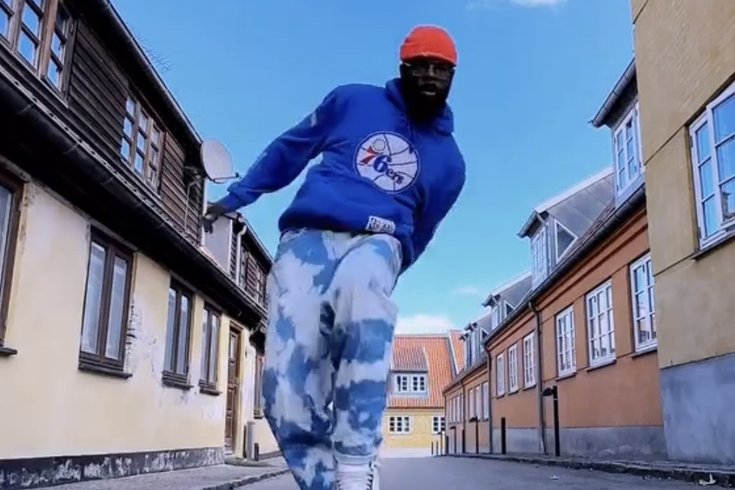
February 15, 2024
 @briceprofessorlock/Instagram
@briceprofessorlock/Instagram
Brice Johnson, who learned hip hop on the streets of West Philly, now helps people use dance for self-discovery and psychological wellbeing – an approach backed by recent research.
Brice Johnson thought he was going to be a soccer star. But when a high school injury derailed his dreams, he stumbled into hip hop – which turned out to be his true calling and his path to wellbeing. It's a journey the Philadelphia-bred dancer now shares with others around the world.
Johnson grew up in Willingboro, Burlington County, but spent his summers with his grandmother in West Philly, where he started to pick up street forms of dance, eventually joining friends in a hip hop crew called The Hood Lockers.
He has performed with Madonna and on the TV show "So You Think You Can Dance." He has choreographed, taught and danced around the globe. But what Johnson ultimately came to realize was that dance was not a road to stardom and acclaim but a way to supersede obstacles and live a more authentic life.
Now, Johnson helps others achieve more clarity about themselves and their purposes through dance with his social media tutorials and classes he teaches at his wife's studio, House of Momentum, in Denmark, where he now lives.
And he's not the only one touting these benefits of dancing.
"As a therapist, I understand how not just the physical movement of dance can help release all kinds of emotions in our bodies, but also connect with meaningful lyrics and tell stories and foster creativity," said Francesca DiGregorio, a mental health counselor in Havertown, Delaware County, who trained in ballet, lyrical, tap and jazz growing up.
A recent study published in the journal Sports Medicine revealed that structured dance programs of at least six weeks gave significant benefit to individuals' psychological and cognitive health – even outperforming other physical activities. Dance also helped with community building and is a sustainable form of exercise across diverse populations, the study showed.
This research reaffirmed what DiGregorio has seen play out in her own life as a dancer, and in her work. She called the studio a "second home" and noted that she once ended a teenage group therapy session with the Cupid Shuffle.
"I saw smiles and laughs from teens I hadn't seen in weeks," she said. When they asked her why it was lifting their spirits, DiGregorio explained how "it brought us together, we were vulnerable with one another and could laugh along with each other."
Dancing together also demonstrated how they could "stay in the moment and practice mindful movement," DiGregorio said.
Johnson recalled a pivotal experience when he was dancing at a club and started crying: "The more the tears came, the deeper I went into the music. … It was almost like the music was giving me a mother's hug, and it was just me knowing how much I loved dancing and how much it was a necessary part of my life."
After giving a TED Talk entitled "We Dance How We Live" – veering off his well-prepared script but delivering his same heartfelt message to an enthusiastic audience – Johnson realized that the point of all of the trauma he had survived was to use dance to "help people find hope and purpose where there's none and to help people change the way they think about themselves and the world around them."
Johnson's father struggled with addiction. As a young man, Johnson learned that a child he thought was his own was not – that the mother had lied to him.
Johnson went to Los Angeles for "So You Think You Can Dance." The judges voted him off during an early round. Johnson fell into a depression and, with only $160 left, faced impending homelessness.
A friend took him in, and Johnson started making YouTube dance tutorials – before YouTube is "what it is today," Johnson said. Then he started traveling, choreographing, teaching and eventually met his wife, Katrine Gebauer Thorup Johnshon, in Denmark, where they now live with their two boys, 7 and 3.
These days, Johnson teaches hip hop, street and house-style dance at a Danish boarding school and at his wife's House of Momentum studio in Holbaek.
On social media, Johnson started using the hashtag #haveyoudancedtoday, which became his "call to action" for all people, regardless of dance experience, to get up and move, encouraging even those who think they can't dance to give it a whirl if they feel like it.
@briceprofessorlock How to Start Dancing as a Beginner! Have you Danced Today? "Creative Arm Styling" Embrace the power of expressive arm movements - your arms can tell stories! Ready to step into your Groove, and take your dance journey further? Subscribe for more exclusive tutorials and FREE dance classes. #HaveYouDancedToday #DanceLive #DanceTutorials #HowToDance #beginnerdancetutorials #beginnerworkout #LearnToDance #DanceJourney #dancemotivation ♬ A Roller Skating Jam Named "Saturdays" - De La Soul
"If you look at YouTube videos of babies – when you start playing music they start moving," said Johnson, who has 146,000 Instagram followers. "When music plays their body knows, 'This is what I am supposed to do. This is how I am supposed to react to it. You can reconnect with that."
Learning a little hip hop can help someone look slick on the dance floor at a class reunion or a wedding, but more importantly, Johnson said, dance can help people learn more about themselves.
"Oftentimes, you find the way somebody approaches their dance – especially non-professional dancers – says a lot about how they think about themselves and the areas that are holding them back in life," Johnson said. "Instead of teaching you how to dance, I teach you how to use dance as a tool to express yourself and to find your purpose."